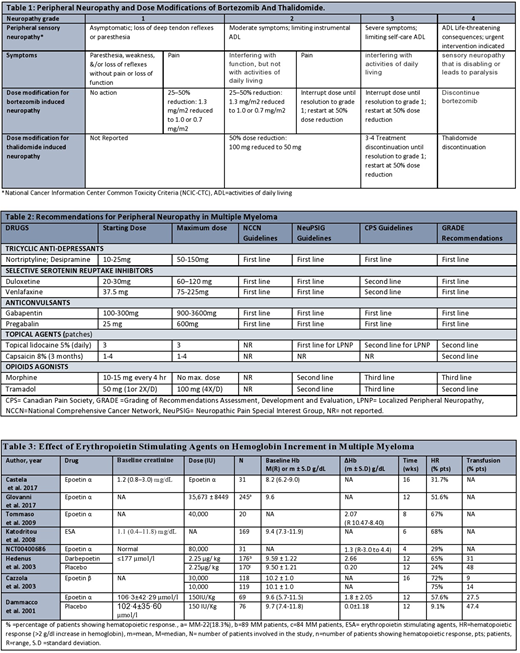Abstract
Introduction:
Multiple myeloma (MM) is associated with end organ damage that negatively impacts the quality of life (QOL)and supportive care has a potential to improve symptoms.
Methods:
After detailed search on Pubmed, Cochrane, Embase and Clinical Trials.gov, we finalized total 36 articles on supportive care published after 2004.
Results:
Management of skeletal events: Mhaskar et al. (2017, n=3257) compared bisphosphonates (BPs) with placebo (PBO) in preventing pathological vertebral fractures, skeletal-related events (SRE), reported risk ratio (RR) of 0.74 in each; 95% CI 0.62-0.89 and 0.63-0.88 respectively. Both zoledronic acid (ZA) and clodronic acid prevent SRE, but mortality rate was better reduced with ZA (hazard ratio [HR]=0.84; p=0.0118), (Gareth et al. 2010, n=1960). In a study by Zuradelli et al. (2009, n= 240); hypocalcemia developed in 93 (38.8%) patients on ZA for a median of 2.3 months (range, 0-34.9). Vitamin D and calcium replacement is essential in patients developing hypocalcemia with BPs, (Kennel et al. 2009). Vertebral augmentation procedures improved pain after compression fracture (n=923) by 4.8, 4.6 and 4.4 points at 1 week, 1 year and beyond 1 year respectively, (Khan et al. 2014). Valerie et al. (2011, n=84) analyzed improvement in bone pain with radiotherapy (median 45 grays) in 92 % patients.
Prophylaxis of infections: Leng et al. (2018, n=70,687) observed reduced risk of herpes zoster (HZ) reactivation in patients on bortezomib or carfilzomib + HZ prophylaxis (2.4%) vs 5.8% in non-prophylactic group, (attributable risk reduction: 0.42; 95% CI 0.31-0.56). Teh et al. (2016, n=199) reported reduced risk of varicella zoster virus reactivation with valacyclovir (500 mg) in patients on bortezomib based therapy and following autologous stem cell transplant (ASCT) vs no prophylaxis (HR=0.06 vs 16.9; p<0.01). Dimopoulos et al. (2016, n=569) found higher risk of pneumonia, 8.2% in daratumumab group (n=286) vs 7.8% in control group (n=283). Prophylactic trimethoprim-sulfamethoxazole reduced risk of PCP in 85% patients after ASCT (RR=0.15; 95% CI 0.04-0.62), Stern et al. (2014, n=1000). Incidence of Community-acquired pneumonia (CAP), noninvasive CAP and invasive pneumococcal disease in elderly population (≥65 years) was seen in 49, 33 and 7 patients on Pneumococcal polysaccharide conjugate vaccine group as compared to 90, 60 and 28 patients in placebo group respectively, (Bonten et al. 2015, n=84,496).
Role of plasmapheresis in renal impairment (RI): Alkhatib et al. (2017) showed that plasmapheresis reduced dialysis dependency by removing serum free light chains (sFLC) in patients with RI (n=147), (RR 0.45; P = 0.02). Yu-X et al. (2015, n=147), showed lower 6-month dialysis dependency ratio with plasmapheresis and chemotherapy (PP + CTH) vs CTH alone, (15.6% vs 37.2%; RR=2.02; p = 0.04). High cut-off hemodialysis lowered sFLC level in 61% (n=42) and 63% patients at day 12 and 21 respectively. Out of these, 71% and 69% patients became dialysis independent, (Hutchison et al. 2012, n=67).
Peripheral neuropathy (PN): Bortezomib caused PN in 124/331 (37%) patients (Richardson et al. 2009) whereas with thalidomide, the incidence of PN was 38% and 73% at 6 and 12 months, respectively, (Mileshkin et al. 2006, n=75). PN improved in 68% patients on bortezomib with dose modifications (n=72) vs 47% patients, without dose modification (n=19). (Table 1 and 2). Significant improvement in PN was seen with duloxetine vs placebo (1.06 vs. 0.34; p= 0.003), (Smith et al. 2013, n=231). Arbaiza et al. (2007, n=36) showed improvement in neuropathic pain with tramadol (p= < 0.001).
Epoetin and derivates for anemia: Castelli et al. (2017, n= 31; median creatinine 1.2 mg/dL (0.8-3.0)) reported hemoglobin (Hb) increase of ≥1g/dL and ≥2g/dL in 71% and 31.7% patients respectively with epoetin α, transfusions requirement reduced from 2.39 ± 1.05 to 1.23 ± 1.36 (p < 0.001). Begiun et al. (2013, n= 72) compared the effect of darbepoetin (D) ± iron (Fe) vs placebo on erythroid recovery after ASCT. All patients receiving D + Fe achieved Hb ≥13 g/dL (p<0.0001). Tonia et al. (2012, n= 16,093) showed 35% decrease in transfusion need with erythropoietin stimulating agents (RR=0.65; 95% CI 0.62-0.68). (Table 3)
Conclusion:
Along with anti-myeloma chemotherapy therapy, management of complications (anemia, infections, renal insufficiency) and other associated symptoms is necessary to improve the quality of life.
No relevant conflicts of interest to declare.
Author notes
Asterisk with author names denotes non-ASH members.


